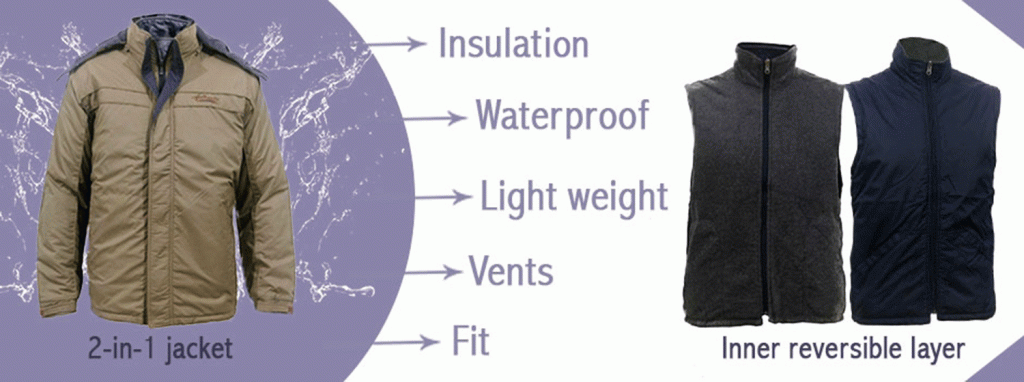
As I mentally tick items off our Traveller’s Checklist – penknife, first-aid kit, technical gloves – I hit a snag. My trusty old outdoor jacket has seen one too many winters and there is no way I can leave without a new one. Having travelled to Sikkim, Dalhousie and Darjeeling among other winter destinations, here are the features I look for before purchasing a new outdoor jacket.
As I mentally tick items off our Traveller’s Checklist – penknife, first-aid kit, technical gloves – I hit a snag. My trusty old outdoor jacket has seen one too many winters and there is no way I can leave without a new one. Having travelled to Sikkim, Dalhousie and Darjeeling among other winter destinations, here are the features I look for before purchasing a new outdoor jacket.
First off, insulation! It is an important feature of an outdoor jacket, serving to keep warm or to simply maintain comfortable body temperature.
Insulation
You could go either with a natural fabric like wool, cotton and fleece or a synthetic insulator, like polyester or faux fur. Technology these days allows polyester to be lightweight and insulating. Also, polyester dries up much faster than natural fabrics, making it more efficient at keeping you warm. This brings us to the next important feature – water resistance.
Water Resistance
If there is a chance of rain or snow, a waterproof or water-resistant jacket will make a world of difference to your trip! As it nullifies the need to wear a raincoat or carry an umbrella, it not only cuts down on the weight of your luggage but also leaves you with one less garment to wear on your person. Jackets that have been treated with Water Repellent finishes work as well to stop the face fabric wetting out and maximise breathability.
Most water-resistant shells are also wind resistant, thus protecting you in stormy weathers where the temperature may be moderate but the wind chill factor is high.
Unfortunately, even the most breathable waterproof fabric can make your body feel stuffy. The next feature easily solves that problem.
Vents
These are zip openings in your jacket that you can open and shut close to control how much air gets into your jacket. Ideally situated below your arms and on the chest, the vents allow airflow when you get uncomfortably warm also relieving you of excess moisture built up during outdoorsy activity.
Although armed with all these great protective features, your jacket should not be bulky. An outdoor jacket that is both heavy and large is annoying and impractical. If you have ever owned one of those, you will realise why, especially to people of a smaller build, a lightweight jacket seems heaven-sent.
Lightweight
A lightweight jacket will ensure that even with its features to provide you with warmth and protection, it will not weigh you down. Since winter wear is all about layering, a lightweight jacket over all those layers reduces the bulk and weight on you, while still keeping you warm. It will also be easier to carry and occupies less baggage space.
Have you spotted a jacket with all of these features? You have? Then it is time to look for the perfect fit.
Fit
If you are comfortable with a jacket that is on the looser side, go for it! Prefer one with a snug fit? Do not settle for anything less! However, keep in mind the layers of clothing you plan on accommodating underneath the jacket. Ill-fitting winter wears bunching up underneath an ill-fitting jacket has left many a traveller miserable. Needless to say, the 2-in-1 Jacket has been a huge relief to many in this regard! “How,” you ask? Read on.
2-in-1 Jacket
Firstly, a 2-in-1 jacket will serve you regardless of the changes in weather – it could be warm at base camp but how accurately can you predict the weather at the top of the mountain? A 2-in-1 jacket gives you the warmth of two layers but when you find temperatures rising, simply shrug off the outer layer.
Secondly, with a 2-in-1 jacket style, you will also be assured that the fitting of one over the other will not be a squeeze. The jackets are manufactured and zipped together to be a perfect fit for each other. Even the ends of the sleeves will have fastenings that prevent the sleeve of the inner jacket from riding up your arm.
Now that we have covered every feature to ensure your body is protected neck-down from the elements, how about looking out for the area above it – your head.
A Detachable Hood
Jackets usually come with a high collar that protects your neck. Look out for one with a hood of the same fabric buttoned or zipped to it. A hood will protect your head from oncoming rain or snow, shield your ears from cold winds and protect your head from the cold. When the weather gets warm or drier, you can simply roll the detachable hood and tuck it away into a pocket. This brings us to the next important feature – Pockets.
Pockets
Pockets can provide a place to stash all of your travel essentials including a map, electronic items, keys, etc. As the outer fabric is made up of waterproof or water-resistant material, the items will stay dry. Inner pockets are ideal for storing valuables while keeping your hands snug and warm with inseam pockets on the sides.
Zips securing the pockets and pretty much every other opening of the jacket are not always water repellent. This leaves them susceptible to water seepage. Hence, the next feature is crucial as it will prevent any such seepage.
Storm Flap
A storm flap is a little flap of material that goes in front of the zip to shield it from oncoming rain. Velcro patches secure the flap firmly in place. Should you come up against furious weather while making your way up the Himalayas, a storm flap will offer you extra protection. Wind and rain can penetrate your outdoor jacket through the teeth of the zip and a storm flap is designed to cover it to keep the elements out. All the zips on the jacket (pockets, hood base) should ideally have storm flaps with Velcro. In humid weather conditions, especially with oncoming rain, you can leave the zips open but have the Velcro patches done up so that you are not totally exposed.
Seam Sealed
Have you noticed clothing with plastic strips covering its stitching? These are known as seam seals. They work in the same way that storm flaps do – they waterproof every seam from inside the jacket.
Colour
It is always a nice change from the blacks, browns, greys and navy, not to mention how good your bright, coloured outdoor jacket will look standing out against white scapes on photographs.
To sum it all up, your outdoor jacket should be lightweight, durable, water-resistant and insulating. Look for products that promise strength, durability and longevity of the jacket.
Armed with the right outdoor jacket, I feel like I could take on the world! Are you about to embark on your next big adventure too? We, at Kosha, wish you warm travels and would love to hear about your experience over a cup of coffee. So drop us a line, an email, or simply a comment below. Bon voyage!


